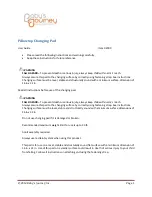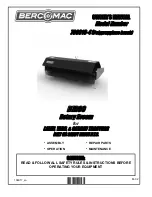
These operating instructions are a publication by Conrad Electronic SE, Klaus-Conrad-Str. 1,
D-92240 Hirschau (www.conrad.com). All rights including translation reserved. Reproduction by
any method, e.g. photocopy, microfi lming, or the capture in electronic data processing systems
require the prior written approval by the editor. Reprinting, also in part, is prohibited. These ope-
rating instructions represent the technical status at the time of printing. Changes in technology
and equipment reserved.
© Copyright 2011 by Conrad Electronic SE.
DISPOSAL
a) In general
Once the product becomes unusable, dispose of it in accordance with the
relevant statutory regulations.
b) Batteries and Rechargeable Batteries
The end user is legally obliged (Battery Regulation) to return used batteries and
rechargeable batteries. Do not dispose of used batteries in the household waste!
Contaminated batteries/rechargeable batteries are labelled with these sym-
bols to indicate that disposal in the domestic waste is forbidden.
The symbols for dangerous heavy metal constituents are: Cd=cadmium,
Hg=mercury, Pb=lead (name on battery/rechargeable battery, e.g. under the
trash icons on the left).
You can dispose of your used batteries/rechargeable batteries free of charge at your
community’s collection point or any place where batteries/rechargeable batteries
are sold!
You thereby fulfi l your statutory obligations and contribute to the protection of the
environment.
TECHNICAL DATA
Temperature:
Measurement range ................... -20.0 °C to +60.0 °C
Nauwkeurigheid ......................... +
– 1 Ð
Defi nition ...................................... 0.1 Ð
Air humidity
Measurement range ................... 25% to 90% relative humidity
Nauwkeurigheid .......................... +
– 5% (in the range from 25% to 80%)
Defi nition ...................................... 1%
General information:
Power supply ............................... 2 batteries of type AA/Mignon
Battery life ................................... approx. 12 months
Transmission frequency ............ 433MHz
Transmission range .................... Up to 100 m (open space, see chapter “Range”)
Measurement cycle .................... approx. every 43 - 47 seconds
Dimensions .................................. Approx. 110 x 60 x 32 mm (H x W x D)
If the outdoor sensor that was enclosed with your weather station does not
have an option to set the transmission channel, that outdoor sensor is nor-
mally set permanently to channel 1. Adjust the outdoor sensor provided here
e.g. to channel 2.
SETUP AND MOUNTING
-
The installation site for the outdoor sensor should be chosen so that it is located
in a place that is protected from precipitation (e.g. under eaves); otherwise the
sensor will no longer be able to measure the air temperature.
Nor should the sensor be exposed to direct sunlight (faulty measurements due to
sunlight exposure).
-
Keep a suffi cient distance away from metallic surfaces, cables, power outlets or
electrical devices, since they reduce the radio range.
-
The outdoor sensor can be hung, e.g. on a screw or hook, by means of the open-
ing for wall mounting (6).
-
The outdoor sensor can also be used standing up.
Take care that the outdoor sensor is placed so it does not stand in or under
water (e.g. during rainfall), since water may enter through the holes in the
bottom. The outdoor sensor must also not fall over!
The outdoor sensor must not be operated in or under water, since this will
destroy it!
RANGE
The range of transmission of the radio signals from the outdoor sensor to the base
station is up to 100m. under optimum conditions. This is often also called “free fi eld
range”.
However, this ideal arrangement (e.g. weather station and outdoor sensor on a plain,
even meadow without trees, houses etc.) never exists in practice.
Normally, the weather station is installed in the house and the outdoor sensor for
temperature and air humidity is mounted on the exterior of the house next to a
window.
Due to the different infl uences on the radio transmission, no specifi c range can be
guaranteed.
However, trouble-free operation is usually possible in a detached house.
If the weather station doesn’t receive any data from the outdoor sensor (despite
new batteries), reduce the distance between outdoor sensor and weather station, or
change the installation site of the devices.
The range can sometimes be limited considerably by:
-
walls, reinforced concrete ceilings
-
coated/vapour-deposited insulating glass panes
-
Vehicles
-
trees, bushes, earth, rocks
-
the proximity to metallic & conductive objects (e.g. heating elements)
-
proximity to human bodies
-
broadband disruptions, e.g. in living areas (mobile phones, wireless headphones,
wireless speakers, other weather stations, etc.)
-
proximity to electrical motors, transformers, mains adapters, computers, cables,
power outlets or other electrical devices
CLEANING AND MAINTENANCE
The product is maintenance-free for you; you should never dismantle it (except for
inserting/replacing the batteries or rechargeable batteries as described in these op-
erating instructions).
Use a clean, dry, soft cloth for cleaning the outdoor sensor.
Do not apply too much pressure to the display, as this can cause scratch
marks or failures of the display.
Do not use abrasive cleaning agents, cleaning alcohol or other chemical so-
lutions, since these could damage the housing or even impair operation.
Do not point a garden hose or other irrigation system or a high-pressure
cleaner at the outdoor sensor; doing so will destroy it.
DECLARATION OF CONFORMITY (DOC)
We, Conrad Electronic, Klaus-Conrad-Straße 1, D-92240 Hirschau, hereby declare
that this product conforms to the fundamental requirements and the other relevant
regulations of the directive 1999/5/EC.
You can fi nd the declaration of conformity (DOC) for this product at
www.conrad.com.


























